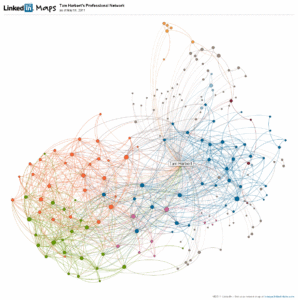
My LinkedIn Network
Platform. That is the buzzword at writing conferences lately.
These days, authors and journalists must build more than a story using words. We have to build a platform by virtually networking: linking up with professional connections, rounding up friends and getting people to follow our every little tweet. In several sessions at the recent annual conference of the American Society of Journalists and Authors (ASJA), speakers said that a writer’s chances of getting a book deal or a story assignment instantly increased if she could show she had a big network. A network of readers who breathlessly await her next brilliant blog post, online article or tweet. Who are clamoring for a video or podcast from her. Or better yet, an e-book.
In short, editors want us to bring our own audience.
I’ve made a modest start. I own my domain name – www.tamharbert.com. I have a blog. I’m on LinkedIn. I’m on Facebook, although apparently I am making a mistake by mixing up my family, friends and business associates. To further my professional platform, I should have a Facebook Profile (which used to be called a fan page.) I’m meekly beginning to tweet.
How many social media channels does it take to build a platform? At the podcasting session, someone recommended posting podcasts on the Public Radio Exchange to attract an audience. “Think of it as your very own radio show,” she said. I was so traumatized by all the platform talk that as soon as I got home I spent a couple hundred bucks buying up a bunch of domain names – .coms, .nets, .orgs – even a .tv – just to stake out my claims to potential spots where I might, someday, build out my platform. That last one – a domain name on YouTube – was because one of the ASJA panelists thought that would be the next big thing. I don’t even like having my picture taken. What am I going to do with my own TV channel?
In fact, I so don’t like photos of myself that I use my logo instead of my picture on social networks. That logo is part of my effort to “build my brand.” But I’m starting to wonder whether that’s a mistake. At the conference, ASJA arranged for a photographer to offer a special deal on professional headshots for attendees. An edgy photo has become part of a writer’s brand, at least for some. A few of the business cards I collected had headshots on them, the same headshot the writer had on Facebook, Twitter and LinkedIn. My business card, like my social media sites, has my logo. I either have to change to a photo or start wearing my logo, writ large, at conferences.
Is it all worth it? I don’t know. I’ve added a few planks to my platform. I’ve gained a few more followers on Twitter, added a couple friends and linked into several potentially valuable professional contacts. But I now find myself pre-occupied with my shabby numbers. Only 150 friends. About 60 followers. And I’ve succumbed to platform envy. I’m spending way too much time checking out other writers, astounded at the number of people they’ve connected to. As if that’s not enough, today I find out (via Compukol’s blog post) about Klout, a company that measures your overall influence online. My score: a measly 27 out of 100. Klout tells me I have “a small but tightly formed network that is highly engaged.”
Maybe that’s good for a journalist that specializes in a few niches, as I do. Maybe Klout was just trying to make me feel better. But even as I complain about all this social networking, I must admit that I’m better suited to networking online than the old-fashioned way (in person). As a writer, I prefer cocooning in my office to the grin-and-grab circuit. After a couple of days schmoozing at a conference I need to hibernate for a week. But online I can use my writing skills to be witty and smart. I can socialize on my timetable. I can pick the people I want to talk to. I may not win any online popularity contests, but I will gradually build a strong platform, one plank at a time.
